Tips for choosing the right X-ray detector backplane for your needs
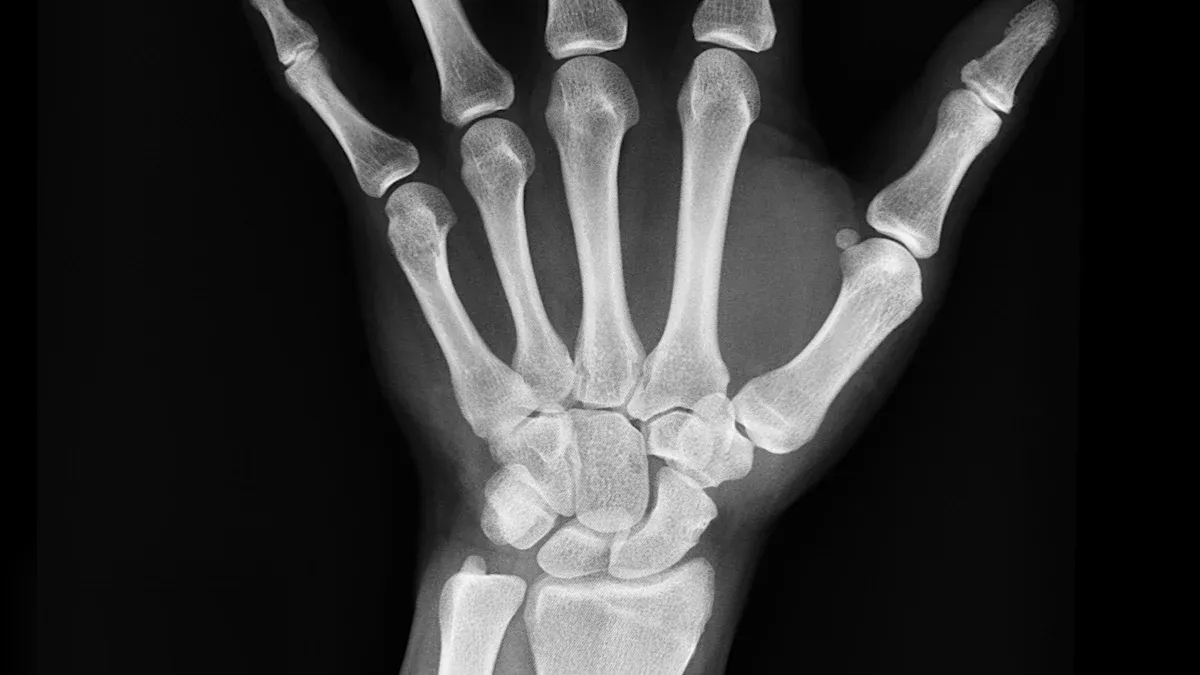
When selecting an X-ray detector backplane for your X-ray system, it’s important to consider how its features will impact your imaging results. The X-ray detector backplane serves as the foundation of your X-ray system, converting X-rays into digital images for analysis or diagnosis. Matching the technical specifications of the X-ray detector backplane to your specific requirements is essential. For instance, in a medical X-ray system, high resolution ensures clear and detailed images, a low dose enhances patient safety, and fast imaging speed allows for quick image acquisition. The table below highlights how these features influence your decision:
Feature | Impact on Selection |
|---|---|
Resolution | Higher values provide greater detail, which is crucial for medical X-ray system applications. |
Dose | Lower dose increases safety, which is especially important for patient X-ray system use. |
Speed | Faster speed enables your X-ray system to perform rapid imaging without unnecessary delays. |
The BOE X-ray detector backplane stands out as a leading choice, offering advanced technology to meet the needs of both medical and industrial X-ray systems. With the BOE X-ray detector backplane, you can expect superior performance and reliability for your imaging applications.
Key Takeaways
Pick a backplane that gives sharp and clear images. Good images help doctors find problems faster.
Use a detector that needs less radiation. This keeps patients and workers safer. Safety is very important in medical imaging.
Think about how fast the X-ray detector works. Faster detectors help people work quicker. This is helpful in busy places.
Make sure the detector size matches what you need. Big panels are good for large areas. Small panels fit better in small spaces.
Check for new features like digital design and 5G. These make images better and help with remote checks.
Choosing an X-ray Detector Backplane
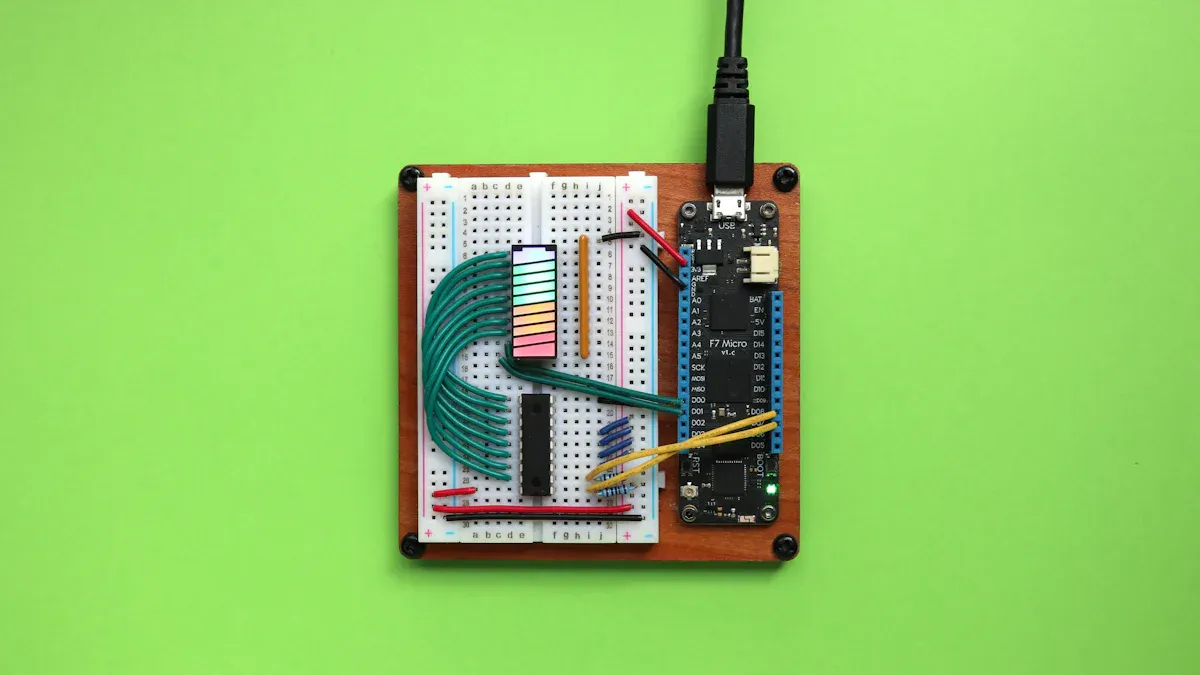
Image Quality and Resolution
When you pick a dr panel, you want clear images. Good image quality is very important for your work. You should check for high contrast, the right density, and sharp resolution. These things help you see small parts and tiny changes in tissues or materials. If your images are clear, you can make better choices when you check or diagnose something.
Criterion | Definition |
|---|---|
Exposure Index (EI) | Tells you how many x-ray photons hit the dr panel, and it is related to the signal-to-noise ratio. |
Signal-to-Noise Ratio (SNR) | Shows how well the dr panel gets the signal compared to background noise. |
Contrast | The difference between light and dark areas, which helps you see details. |
Density | How dark the image is, making sure you can see all the parts. |
Resolution | How sharp the image is, so you can see small things clearly. |
BOE’s dr panel uses new technology to make images clear. It has a high signal-to-noise ratio and a wide dynamic range. These help you get the best image quality. If you work in medical imaging or checking machines, you need dr panels that give sharp and correct results.
Radiation Dose and Sensitivity
Radiation dose and sensitivity are very important when you choose a dr detector. You want to use the lowest dose you can, especially in medical imaging. Low-dose dr panels help keep patients and workers safe by lowering exposure. High sensitivity means the dr panel can still make clear images, even with less radiation.
Modern dr panels, like BOE’s, use new materials and digital design to be more sensitive. These panels can make good images with less radiation than old systems. This means you get safety and good performance. In hospitals, low-dose dr panels help lower risk and keep image quality high.
Speed and Workflow Efficiency
Speed is important in both hospitals and factories. Fast dr panels let you take images quickly, which helps in emergencies or busy places. You want a dr panel that can take images fast and help you work smoothly.
Today’s wireless dr panels can read up to 300 frames each second. This means you can see images almost right away. BOE’s digital dr panels use new electronics and 5G to send data fast and help with remote checks. These things help you work faster and give better care or inspections.
Tip: When you pick a dr detector, always look at speed and workflow. Fast, wireless dr panels can make your work easier and help patients or clients feel better.
If you focus on image quality, low radiation, and speed, your dr panel will fit what you need for today’s medical and industrial jobs. BOE’s dr panels have these features, plus digital design and AI, so you get the best tools for your work.
DR Panel Compatibility and Size
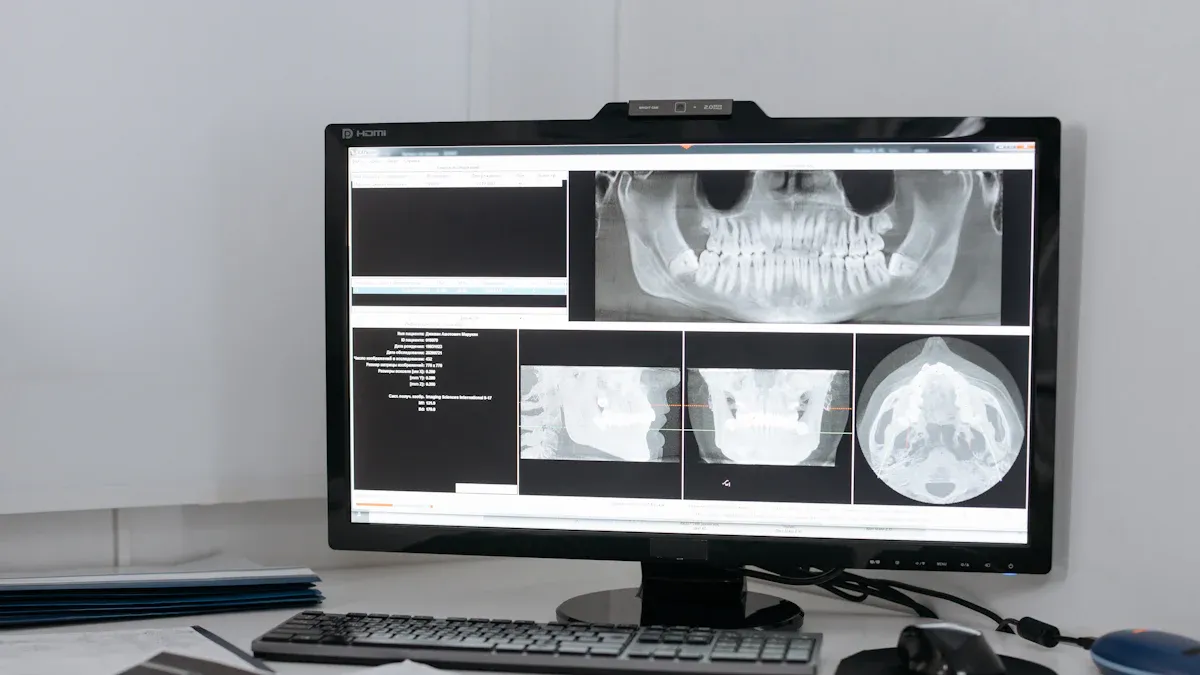
Detector Size Options
You have to pick the right dr panel size for your job. Some sizes, like 17×17 inches, are used a lot in hospitals and factories. BOE has many dr panel models, such as 4317, 1717, 1417, and 1210. Each one is good for different kinds of pictures. Big dr panels can take pictures of large areas at once. This helps when you need chest X-rays or to check big machines. Small dr panels are better for teeth or kids.
Here is a table that shows some detector types and their sizes:
Detector Type | Size (mm²) | Be Thickness (mil) | Energy Range (eV) | Peaking Time (µs) | P/B Ratio |
|---|---|---|---|---|---|
Si-PIN | 13 | 1.0 | 180 – 205 | 32 | 4100/1 |
Si-PIN | 25 | 1.0 | 190 – 225 | 32 | 2000/1 |
FAST SDD® | 25 | 0.3 or 0.5 | 122 – 129 | 4 | >20000/1 |
FAST SDD®-70 | 70 | 0.5 | 123 – 135 | 4 | >20000/1 |
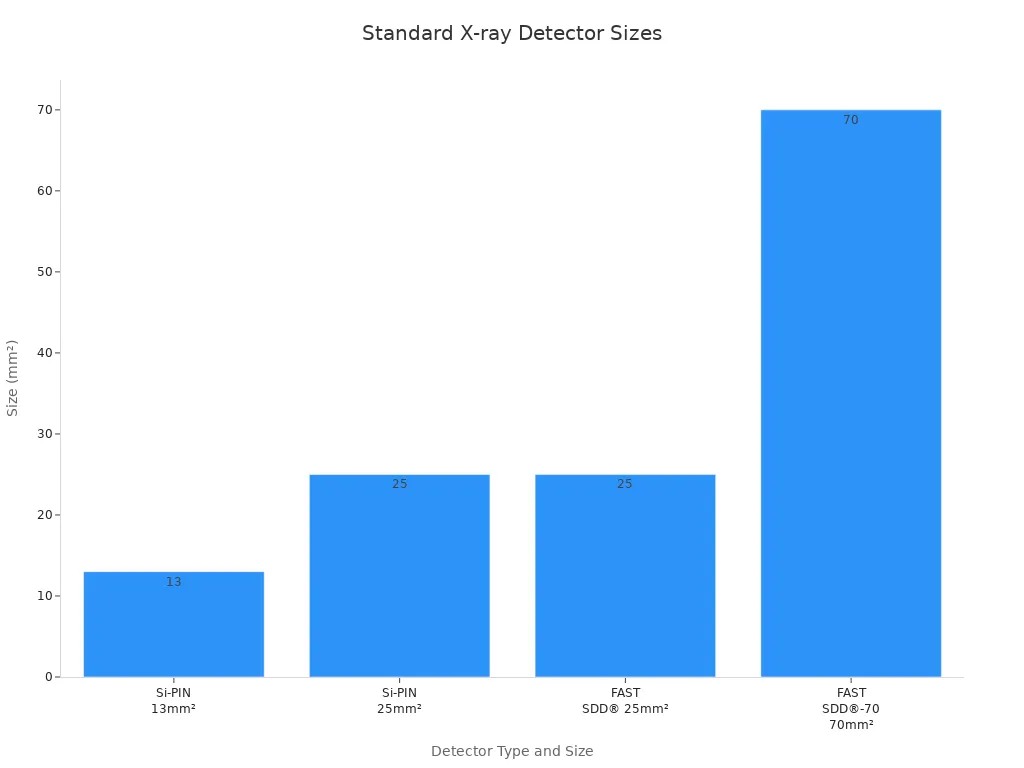
System Integration
You need to make sure your dr panel works with your system. It should fit with both the hardware and software. BOE’s dr panels can connect to most systems because they use digital integration. Tethered dr panels stay connected and send data all the time. You should check if your system can use the panel’s size and digital parts. Doing this helps you avoid problems and keeps things running well.
Detector Size | Impact on Imaging | |
|---|---|---|
Radiography | Up to 43 μm | Finds tiny spots in images |
Cardiology | 30–60 images/second | Watches the heart move |
Computed Tomography | Marginal differences | Makes pictures more exact |
Pediatrics | N/A | Uses less radiation for safety |
3D Reconstruction | N/A | Helps see shapes and diagnose |
Mobility and Space Requirements
Think about where you will use your dr panel. If you work in a busy hospital or a small office, space is important. Flat-panel detectors are light and easy to carry. BOE’s dr panels come in sizes you can move around. You can use them in mobile X-ray units or small rooms. Small panels fit in dental or kids’ rooms. Big panels are best for radiology departments. Pick a panel size that matches your space and how you work.
Tip: Measure your workspace before you buy a dr panel. Portable panels help you work faster and fit in more places.
Durability and Reliability
Build Quality
You want your dr panel to last a long time. Good build quality helps your dr panel work well every day. Companies use strong materials and smart designs for this. The table below shows how each feature helps make the dr panel better:
Material Feature | Contribution to Build Quality |
|---|---|
High X-ray absorption | Enhances detection efficiency and image quality |
High charge transport | Improves signal processing and reduces noise |
Low-cost scalability | Facilitates large area fabrication, making production economical |
Look for dr panels with these special materials. High X-ray absorption gives you better images. High charge transport means you get clearer signals and less noise. Low-cost scalability lets you use dr panels for bigger jobs without high costs.
Longevity in Clinical Use
You want your dr panel to work well for many years. How long it lasts depends on how you take care of it. Doing regular checks keeps your dr panel working right and stops problems. Here are some ways to help your dr panel last longer:
Regular maintenance helps your X-ray machines last longer, including backplanes.
Preventive maintenance finds problems early and keeps your dr panel working well.
Training your staff helps them spot issues fast, so your equipment lasts longer.
If your team knows what to look for, they can fix things before they get worse. Taking care of your dr panel keeps it safe and reliable. When you do these things, your dr panel will work well in clinics, hospitals, or factories.
Tip: Always check your dr panel on a schedule. This easy step helps you avoid problems and keeps your images clear.
Cost and Value
Budget Planning
When you buy a dr panel, you need to think about your budget. The price depends on what features and technology the dr panel has. Some dr panels cost $15,000 to $20,000. These are entry-level models. Others cost $20,000 to $25,000. These are intermediate models. The most expensive ones cost $26,000 to $50,000. These are premium models. Here is a table that shows the price ranges:
Category | Price Range | Description |
|---|---|---|
Entry-Level | $15K-$20K | Tethered and/or Gadox-based panels |
Intermediate | $20K-$25K | Wireless panels |
Premium | $26K-$50K | Glassless and wireless charging panels |
You also need to think about extra costs. These can be for installation, getting the room ready, calibration, safety checks, and connecting to your network. Here are some common extra costs:
Installation services: $1,000 - $3,000
Room preparation: $5,000 - $15,000
Equipment calibration: $2,000 - $10,000
Radiation safety testing: $500 - $2,000
Network integration: $1,000 - $5,000
Note: Maintenance contracts and surprise repairs can make your costs go up. Always remember to add these to your budget.
Cost-Effectiveness of Best DR Panel
You want a dr panel that works well and is a good deal. When you look at different dr panels, check both the price and how well they work. BOE’s dr panel has advanced features but costs less than many other brands. For example, BOE panels are usually 30-40% cheaper than Samsung models. You can buy BOE panels from many places. This helps keep prices steady and shipping easy.
To find the best deal, look at the total cost of owning the dr panel. This means you think about:
How much you pay at first
How much it costs to use and fix
How long the dr panel will last
Yearly costs and how often you use it
Costs for spare parts, upgrades, and training
Picking a dr panel with good value, like BOE, helps you save money over time. You get clear images, reliable work, and lower costs in the long run. When you buy a dr panel, balance your budget with the features you need. This way, you get the best dr panel for your work and your money.
Special Features and Advanced Technology
Digital Design and 5G Integration
You want your imaging to be quick and easy. BOE’s dr panel uses digital design and 5G to help you. Digital design gives you sharp images fast. 5G lets you send big files in just seconds. This makes remote diagnosis possible.
Benefit | Description |
|---|---|
Lets you take pictures quickly and keep working. | |
Excellent picture quality | Gives you clear images for better checks. |
Wide product range | Offers many choices for different needs. |
With 5G, you can move a 3 GB MRI file in under 20 seconds. Older networks take much longer to send big files. You can use AI to check images right away. This can cut diagnosis time by half for urgent cases. Remote slide reviews get faster and more exact. These features help you work better and give patients answers sooner.
AI Medicine and Remote Diagnosis
AI medicine helps you use your dr panel in new ways. When you add AI to high-resolution X-ray detectors, you get clearer images and better results. New materials like MAPbI3 make dr panels more sensitive and sharp. This helps AI find problems and helps doctors make good choices.
You can use remote diagnosis with your dr panel because of 5G and AI. Doctors can look at images from anywhere and help right away. This helps patients in far places or busy hospitals get care faster. These features make your work easier and help you give better care.
Tip: Pick a dr panel with digital, 5G, and AI features so your imaging center stays ready for new technology.
How to Pick the Best DR Panel
Looking at Specifications
When you want to pick a dr panel, check the main details. These details help you know which panel is best for you. You should look at image quality, how easy it is to carry, battery time, and speed. The table below shows how two DR panels compare:
Specification | Vieworks ViVIX N | Konica AeroDR Premium |
|---|---|---|
Panel Weight | 6.4 lbs. | 5.7 lbs. |
Pixels | 2560 x 3072 | 1994 x 2430 |
Battery Life | 8 hours | 8.2 hours |
Cycle Time | 10 seconds | 6 seconds |
Pixel Size | 140 µm | 175 µm |
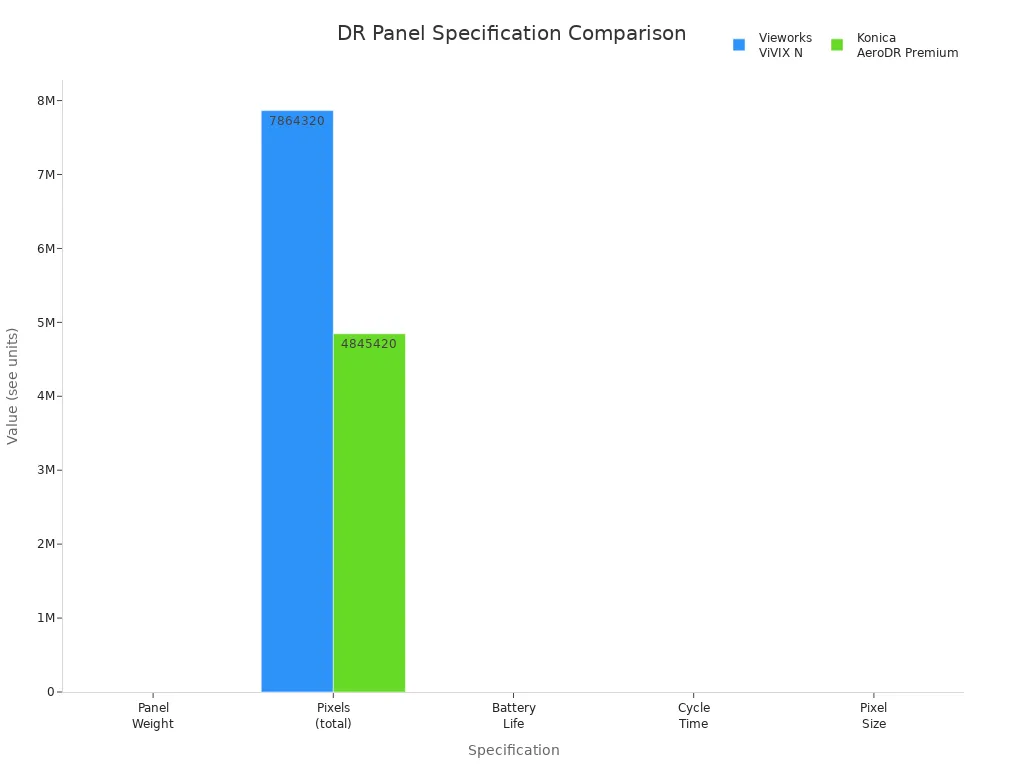
You should also see if the panel is wireless or needs a cable. Check if you can change settings like exposure, brightness, and contrast. These things help you use the panel every day.
Tip: Pick a panel that fits your work. A light panel with quick speed is good for busy places.
Manufacturer Help and Certification
Getting help from the company is important when you pick a dr panel. You want a company that helps you with problems and cares about its products. Look for certifications like ISO 9001:2015 or AS9120:2016. These show the company checks its products and follows rules. Good help and certified panels mean you can trust your panel to work well and last longer.
Certifications show the panel is made well.
Industry rules and tests make panels more reliable.
Good tracking and care help you avoid trouble.
User Reviews and Real Examples
You can learn from what other people say and real stories. When you pick a dr panel, read reviews and look at case studies. People talk about how clear the images are, how long the panel lasts, and if it works well over time. For example, panels with a-IGZO or LTPS TFTs keep pictures sharp and work well, even after lots of use.
Mobile units need wireless panels for easy moving and quick work.
Clinics like small, low-cost panels for tight spaces.
Hospitals want panels with more features for lots of patients.
Note: Ask people who know and read real stories before you choose. Real feedback helps you make a good choice and avoid problems.
When picking an X-ray detector backplane, think about image quality, dose, speed, size, and how long it will last. Make sure these features fit what you need. This helps you get the best results. New technology like digital design, 5G, and AI can make your work easier and help patients more.
Tip: Talk to trusted companies like BOE to find what works for you. You will get better help and results if you choose products made for your needs.
FAQ
What is an X-ray detector backplane?
An X-ray detector backplane changes X-rays into digital pictures. This part is very important in your digital radiography system. It helps you get clear and correct images.
How do I choose the right size for my DR panel?
Pick a panel size that fits your imaging job. Big panels are good for chest X-rays or checking machines. Small panels are better for teeth or kids.
Why is low radiation dose important?
Low radiation dose helps keep you and patients safe. You get less exposure but still have good images. This matters a lot in hospitals and clinics.
Can I use BOE’s DR panels with my existing system?
Yes, BOE’s DR panels work with most digital systems. You can connect them to many modern imaging machines. Always check if your equipment matches before you buy.
What advanced features should I look for?
Find panels with digital design, 5G, and AI support. These features give you faster images and remote checks. They also help you work smarter.
See Also
Essential Features To Consider For Gaming Monitors
Understanding LED And LCD Monitors For Your Needs
Seven Essential Tips For Choosing An 8K Monitor